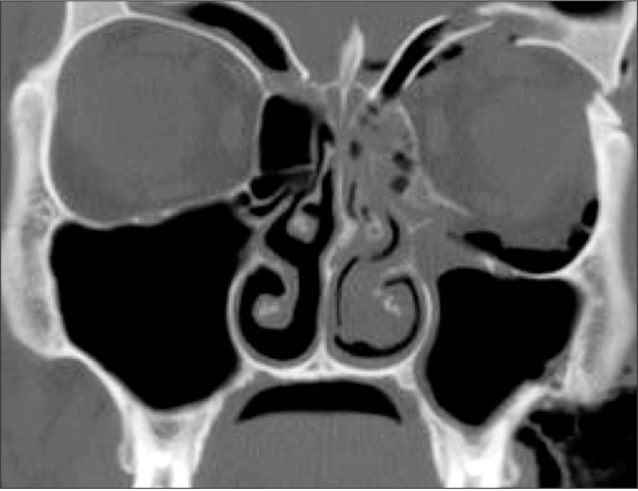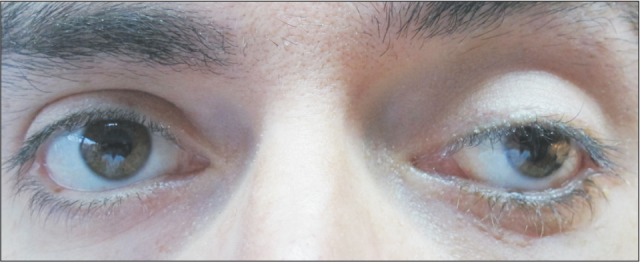J Korean Assoc Oral Maxillofac Surg.
2017 Feb;43(1):42-45. 10.5125/jkaoms.2017.43.1.42.
Chemosis as complication in transconjunctival approach for orbital trauma
- Affiliations
-
- 1Department of Oral and Maxillofacial Surgery, Universidad de La Frontera, Temuco, Chile. sergio.olate@ufrontera.cl
- 2Center for Research in Biomedical Sciences, Universidad Autónoma de Chile, Temuco, Chile.
- 3Department of Oral and Maxillofacial Surgery, Louisiana State University, Shreveport, LA, USA.
- 4Deparment of Oral Diagnosis, State University of Campinas, Piracicaba, Brazil.
- KMID: 2385069
- DOI: http://doi.org/10.5125/jkaoms.2017.43.1.42
Abstract
- The aim of this report was to discuss a complication resulting from a transconjunctival approach to treating an orbital fracture. A 30-year-old male patient presented with a fracture to the zygomatic orbital complex. He was treated with transconjunctival conventional surgical treatment. Two days after surgical treatment, the patient presented with secondary chemosis which was initially slight and then subsequently worsened. The clinical situation was managed with topical and systemic corticosteroids and resolved within one postoperative month. Two-year follow-up showed ptosis of the upper eyelid and limited infraversion in the affected eye. This unusual complication associated with an orbital trauma was resolved with minor functional alterations, although the consequences observed after 2 years were not completely satisfactory.
Keyword
MeSH Terms
Figure
Reference
-
1. Olate S, Lima SM Jr, Sawazaki R, Moreira RW, de Moraes M. Surgical approaches and fixation patterns in zygomatic complex fractures. J Craniofac Surg. 2010; 21:1213–1217. PMID: 20613614.
Article2. Sailer HF. Osteosynthesis of orbital margin fractures via the transconjunctival approach using staples: a preliminary report. J Maxillofac Surg. 1977; 5:184–186. PMID: 269889.3. Baumann A, Ewers R. Use of the preseptal transconjunctival approach in orbit reconstruction surgery. J Oral Maxillofac Surg. 2001; 59:287–291. PMID: 11243611.
Article4. Malhotra R, Saleh GM, de Sousa JL, Sneddon K, Selva D. The transcaruncular approach to orbital fracture repair: ophthalmic sequelae. J Craniofac Surg. 2007; 18:420–426. PMID: 17414295.5. Olate S, Lima SM Jr, Sawazaki R, Moreira RW, de Moraes M. Variables related to surgical and nonsurgical treatment of zygomatic complex fracture. J Craniofac Surg. 2011; 22:1200–1202. PMID: 21772219.
Article6. Manganello-Souza LC, Rodrigues de Freitas R. Transconjunctival approach to zygomatic and orbital floor fractures. Int J Oral Maxillofac Surg. 1997; 26:31–34. PMID: 9081250.
Article7. Novelli G, Ferrari L, Sozzi D, Mazzoleni F, Bozzetti A. Transconjunctival approach in orbital traumatology: a review of 56 cases. J Craniomaxillofac Surg. 2011; 39:266–270. PMID: 20650644.
Article8. Minckler MR, Newell C, Drummond B. Chemosis from trauma. West J Emerg Med. 2014; 15:357–358. PMID: 25035727.
Article9. Prischmann J, Sufyan A, Ting JY, Ruffin C, Perkins SW. Dry eye symptoms and chemosis following blepharoplasty: a 10-year retrospective review of 892 cases in a single-surgeon series. JAMA Facial Plast Surg. 2013; 15:39–46. PMID: 23329270.10. Mateos E, Arruabarrena C, Veiga C, Ruiz-Zarate B, Valdes JJ, Rojo P. Massive exophthalmos after traumatic carotid-cavernous fistula embolization. Orbit. 2007; 26:121–124. PMID: 17613860.
Article11. Makani H, Bangalore S, Romero J, Wever-Pinzon O, Messerli FH. Effect of renin-angiotensin system blockade on calcium channel blocker-associated peripheral edema. Am J Med. 2011; 124:128–135. PMID: 21295192.
Article12. Awdry P. Lymphangiectasia haemorrhagica conjunctivae. Br J Ophthalmol. 1969; 53:274–278. PMID: 5781037.
Article13. Kyprianou I, Nessim M, Kumar V, Chew C. A case of lymphangiectasia haemorrhagica conjunctivae following phacoemulsification. Acta Ophthalmol Scand. 2004; 82:627–628. PMID: 15453870.
Article14. Kim SY, Chung YK, Lee YC, Kim SY. Oral steroid therapy as an adjuvant treatment for severe epidemic keratoconjunctivitis in patients younger than 3 years. Cornea. 2015; 34:182–187. PMID: 25522221.
Article15. Shao EH, Liolios V, Lindfield D, McLean C. Topical adrenaline (1:1000) for the management of severe tarsal conjunctival chemosis. Ophthal Plast Reconstr Surg. 2015; 31:e115–e116.16. Krishnan R, Izadi S, Morton CE, Marsh IB. Use of Frost sutures in an orbital trauma patient with extensive conjunctival oedema and pseudoproptosis. Int J Oral Maxillofac Surg. 2007; 36:649–651. PMID: 17391921.
Article
- Full Text Links
- Actions
-
Cited
- CITED
-
- Close
- Share
- Similar articles
-
- Transconjunctival Approach For The Treatment Of Orbital Trauma
- Treatment of Medial Orbital Wall Fracture Using Medial Transconjunctival Approach
- Repair of Orbital Wall Fracture Using Transcaruncular Approach
- Simultaneous Transconjunctival and Transantral Approach for Repair of Blowout Fracture by using Medpor Orbital Implant
- The Reliability of the Transconjunctival Approach for Orbital Exposure: Measurement of Positional Changes in the Lower Eyelid







